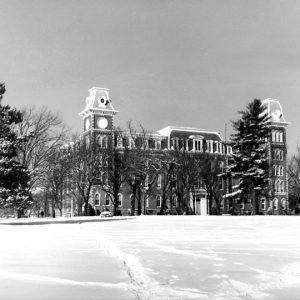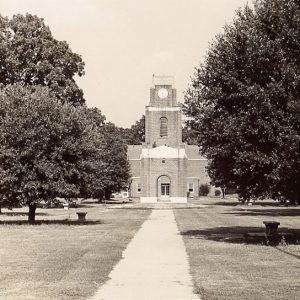calsfoundation@cals.org
University of Arkansas System
aka: UA System
Comprising multiple institutions of higher education and other divisions spread across Arkansas, the University of Arkansas System enrolls more students than any other system in the state. Growing from a single land grant institution into an organization that has a presence in every county in Arkansas, the system included twenty-one separate institutions and divisions by 2024.
The system originated with the establishment of Arkansas Industrial University in Fayetteville (Washington County) in 1871. Serving as the state’s land grant institution as well as the only public institution of higher education in Arkansas, the university began its first session in 1872. The following year, Branch Normal School was established in Pine Bluff (Jefferson County). Founded as part of the university to educate African Americans and prepare them to serve as teachers, the school began operations in 1875. Branch Normal later opened a preparatory department to support students not yet prepared for college-level coursework, and in 1889, the faculty added industrial and vocational coursework to the curriculum. In 1890, the campus also became a land grant institution with the passage of the Second Morrill Act.
The two campuses operated as the only public institutions of higher education in the state until 1908 when they were joined by Arkansas State Normal School (now the University of Central Arkansas) in Conway (Faulkner County).
The next two decades saw major shifts in secondary and post-secondary education in the state with the establishment of four agricultural high schools in 1909. Each of these institutions evolved into junior colleges by the mid-1920s, and all eventually became four-year institutions. Located in Jonesboro (Craighead County), Russellville (Pope County), Magnolia (Columbia County), and Monticello (Drew County), these colleges joined Little Rock Junior College, established in Little Rock (Pulaski County) 1927, and Fort Smith Junior College, established in 1928, to educate the growing number of high school graduates. Henderson-Brown College in Arkadelphia (Clark County) ceased operations in 1929, with Henderson State Teachers College opening on the same campus.
Branch Normal became Arkansas Agricultural, Mechanical, and Normal College (AM&N) in 1927 and became an independent institution in 1929 with a board of trustees.
Little Rock Junior College evolved into Little Rock University in 1957 and became a private institution two years later when the Little Rock School Board withdrew support, turning the institution over to a board of trustees. As Arkansas lacked a public university in the state capital, calls to incorporate the institution into the University of Arkansas system grew over the next decade, culminating in 1969 with Governor Winthrop Rockefeller signing legislation completing the transfer of the campus to state control. The university was renamed the University of Arkansas at Little Rock (UA Little Rock).
By 1971, years of financial problems had led to the addition of Arkansas Agricultural & Mechanical College in Monticello to the UA system. Founded as a regional agricultural high school in 1909, the institution became a two-year institution in 1923 and a four-year college in 1933. Upon joining the system, it became the University of Arkansas at Monticello. On July 1, 1972, AM&N rejoined the system as the University of Arkansas at Pine Bluff (UAPB). The most recent four-year campus to join the system is the former Westark Community College, which began operations as Fort Smith Junior College. Joining the system in 2002, it became the University of Arkansas at Fort Smith.
In addition to the four-year institutions, a number of two-year colleges and specialized schools have also become part of the UA system. A private medical school began operations in 1879 as part of the university. Receiving no funding and little to no oversight from the university, the Medical Department operated in Little Rock. The department merged with another institution, the College of Physicians and Surgeons, in 1911, and began to receive state support. The school adopted the name University of Arkansas School of Medicine in 1918. In 1980, the institution adopted its current name of the University of Arkansas for Medical Sciences (UAMS).
Two law schools have become part of the system: the University of Arkansas School of Law, which operates as part of the Fayetteville campus, and the University of Arkansas at Little Rock William H. Bowen School of Law, housed in the former campus of UAMS.
Located on the grounds of the William J. Clinton Presidential Center and in the nearby River Market District, the University of Arkansas Clinton School of Public Service was established in 2004, the first institution in the nation to offer a graduate degree in public service. Students can also earn dual degrees at the Clinton School and other institutions in the system, including the Bowen School of Law, the Sam M. Walton College of Business at the University of Arkansas in Fayetteville, UAMS, or UA Little Rock. The Arkansas School for Mathematics and Sciences in Hot Springs (Garland County), founded in 1991 to educate high-achieving high school students and beginning operations in 1993, joined the system in 2004 as the Arkansas School for Mathematics, Sciences, and the Arts.
Created in 2014, the University of Arkansas eVersity was based at the system headquarters in Little Rock and designed to offer educational opportunities to Arkansans online, specifically associate and bachelor degrees, along with certificates. In 2021, UA acquired Grantham University, a private, for-profit online university based in Lenexa, Kansas, turning it into University of Arkansas Grantham. On May 26, 2022, trustees for UA approved shutting down eVersity and merging its operations with the UA Grantham, which recorded a fall 2023 enrollment of 4,651.
A total of seven community colleges operate as part of the system, with six including multiple campuses or instructional sites. Phillips County Community College joined the system in 1996 as the Phillips Community College of the University of Arkansas, with a main campus in Helena-West Helena (Phillips County) and additional campuses in DeWitt (Arkansas County) and Stuttgart (Arkansas County). Red River Vocational-Technical School joined the system the same year as the University of Arkansas Community College at Hope. In 2019, the institution became the University of Arkansas Hope-Texarkana, with campuses in both Hope (Hempstead County) and Texarkana (Miller County).
In 1997, Gateway Technical College joined the system as the University of Arkansas Community College at Batesville. Two institutions joined the system in 2001. Cossatot Technical College joined as Cossatot Community College of the University of Arkansas, with its main campus in De Queen (Sevier County) and additional sites in Nashville (Howard County), Ashdown (Little River County), Murfreesboro (Pike County), Dierks (Howard County), and Foreman (Little River County). The college also owns the historic Lockesburg Gymnasium. Petit Jean College also joined the system in 2001 as University of Arkansas Community College at Morrilton, with the main campus in Morrilton (Conway County) and other locations in Perryville (Perry County), Conway (Faulkner County), and Clinton (Van Buren County).
University of Arkansas Rich Mountain and University of Arkansas-Pulaski Technical College both joined the system in 2017. The former operated as Rich Mountain Community College with campuses in Mena (Polk County), Mount Ida (Montgomery County), and Waldron (Scott County), while the latter was named Pulaski Technical College with the main campus in North Little Rock (Pulaski County) and additional locations in Little Rock and Benton (Saline County). In 2024, the boards of the UA System and East Arkansas Community College (EACC) in Forrest City (St. Francis County) both approved EACC joining the system, and leaders at North Arkansas College (Northark) in Harrison (Boone County) began discussions about joining the system.
Other units of the system include the Division of Agriculture, founded by the system Board of Trustees in 1959. Headquartered north of the UA Little Rock campus, the division has offices in every county and operates the Arkansas Agricultural Experiment Station, which has multiple research locations. The Arkansas Archeological Survey is also part of the system. Founded by the passage of Act 39 of 1967, the survey was tasked with creating and maintaining an archeology program in the state. The survey became part of the system in 1977. Offering training to certified law enforcement professionals in the state, the Criminal Justice Institute is based in Little Rock. Founded in 1988 at UA Little Rock, the institute became a standalone member of the system in 1997. The Winthrop Rockefeller Institute, founded in 2005, operates as a member institution of the system, continuing the mission of Governor Winthrop Rockefeller.
The system headquarters at the Cammack Campus in Little Rock include administrative offices and the president’s home. The president’s home was constructed in 1995 and the administrative building in 1997. From the founding of Arkansas Industrial University until 1982, the president of the University of Arkansas in Fayetteville also served as the leader of the system. Individual campuses are led by chancellors, with directors leading the non-academic institutions. In 1982, a chancellor position was created at the Fayetteville campus, and the system offices moved to Little Rock later in the decade. The system appropriation was included in the University of Arkansas in Fayetteville appropriation until 2015. Donald Bobbitt became president of the system in 2011. Bobbitt announced his retirement in 2024, and he was replaced by Jay B. Silveria. The system staff includes positions related to Academic Affairs, Information Technology, Finance Administration, Legal Affairs, and other areas.
The daily operations of the system are led by the president, who is chosen by the Board of Trustees. Those serving on the ten-member board are appointed to ten-year terms by the governor. Individual campuses include a Board of Visitors to advise the chancellor on issues related to the institution.
The individual campuses of the system hold regional accreditation with the Higher Learning Commission, with the exception of the eVersity, which holds accreditation with Distance Education Accrediting Commission.
For additional information:
Anderson, Ryan. “University of Arkansas System Fall Enrollment Up 3% From This Time Last Year.” Arkansas Democrat-Gazette, October 1, 2023. Online at https://www.arkansasonline.com/news/2023/oct/01/university-of-arkansas-system-fall-enrollment-up/ (accessed March 20, 2024).
Baird, W. David. Medical Education in Arkansas. Memphis: Memphis State University Press, 1979.
Friedman, Mark. “Community Colleges Turn to UA.” Arkansas Business, April 14–20, 2025, pp. 1, 12–13.
Higgins, Billy, Stephen Husarik, and Henry Rinne. History of Westark College. Fort Smith, AR: Westark College Foundation, 1998.
———. University of Arkansas–Fort Smith: The First 85 Years, 1928–2012. Fort Smith: UAFS Press, 2012.
Holley, Donald. Celebrating a Century of Opportunity: From the Fourth District Agricultural School to the University of Arkansas at Monticello. St. Louis, MO: Reedy Press, 2009.
———. “The End of an Era: Claude H. Babin and the Merger of Arkansas A&M College with the University of Arkansas.” Drew County Historical Journal 17 (2002): 6–17.
Leflar, Robert. The First 100 Years: Centennial History of the University of Arkansas. Fayetteville: University of Arkansas Foundation Inc., 1972.
Lester, Jim. The People’s College: Little Rock Junior College and Little Rock University, 1927–1969. Little Rock: August House Publishing, 1987.
Neal, Edna. “Changes at the University of Arkansas at Pine Bluff following Merger into the University of Arkansas System.” PhD diss., Indiana University, 1978.
Recken, Stephen L. “Evolving Identity: LRJC to UALR, 1927–1969.” Pulaski County Historical Review 55 (Spring 2007): 13–23.
University of Arkansas System. https://www.uasys.edu/ (accessed March 20, 2024).
David Sesser
Henderson State University
 Education, Higher
Education, Higher CCCUA Campus
CCCUA Campus  Chamberlin Complex
Chamberlin Complex  Grand Prairie Center
Grand Prairie Center  Old Main Building, UA
Old Main Building, UA  Phillips Community College; Stuttgart
Phillips Community College; Stuttgart  University of Arkansas at Fort Smith
University of Arkansas at Fort Smith  University of Arkansas at Pine Bluff Clock Tower
University of Arkansas at Pine Bluff Clock Tower  UACCB Campus
UACCB Campus  UACCM Campus
UACCM Campus  University of Arkansas for Medical Sciences
University of Arkansas for Medical Sciences  University of Arkansas Rice Research and Extension Center
University of Arkansas Rice Research and Extension Center  UA Rich Mountain
UA Rich Mountain 



Comments
No comments on this entry yet.